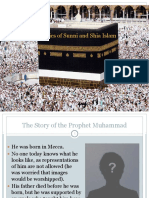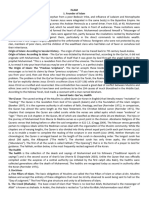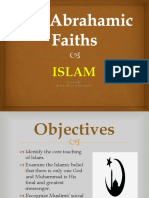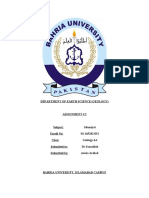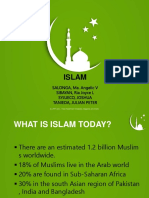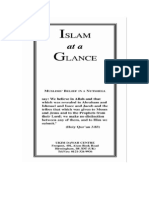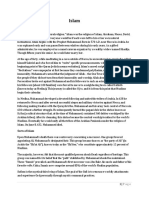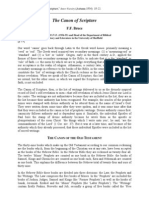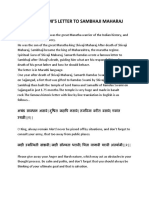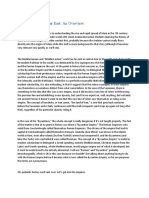Chapter III - Islam
Uploaded by
Liki BossChapter III - Islam
Uploaded by
Liki BossChapter III: Islam
Intended Learning Outcomes:
Familiarize the basics of Islam;
Understand the historical & cultural context of the religion;
Learn about the central tenets & practices of Islam;
Understand the significance of the five pillars in Muslim life;
Explore the sacred texts of Islam & their significance;
Understand the role of the Qur’an & Hadith in Islamic teachings;
Appreciate the diversity within the Muslim community;
Understand the cultural impact of Islam around the world;
Examine the challenges & opportunities facing Islam in contemporary society; &
Discuss the intersection of religion, politics, & globalization.
I. Overview
A. Origin & Meaning of the word “Islam”
The word "Islam" originates from the Arabic root "s-l-m," which carries connotations of
peace, submission, and surrender. In Arabic, "Islam" ( )إسالمis derived from the verb "aslama"
()أسلم, which means "to submit" or "to surrender." Therefore, Islam itself means submission,
surrender, or obedience to the will of God.
The term "Islam" encompasses a comprehensive worldview and way of life centered
around the submission to the divine will of Allah (God). It emphasizes the idea of surrendering
one's desires, ego, and will to God's guidance as revealed in the Qur'an, the holy book of Islam,
and through the teachings and example of Prophet Muhammad.
In a broader sense, "Islam" also denotes peace attained through submission to God,
both individually and collectively. This peace is believed to be achieved by aligning one's life
with the divine purpose and adhering to the principles of justice, compassion, and
righteousness outlined in Islamic teachings. Therefore, Islam is not only a religion but also a
path to inner peace and harmony with the universe.
B. The Life of the Prophet Muhammad & the Revelation of the Qur’an
The life of Prophet Muhammad and the revelation of the Qur'an are central aspects of
Islamic history and theology. Here's an overview:
Life of Prophet Muhammad (570-632 CE):
Prophet Muhammad, born in Mecca in 570 CE, is considered the last prophet and
messenger of God (Allah) in Islam. His life is divided into two main periods: his early life in
Mecca and his later life in Medina.
a. Early Life in Mecca
- Muhammad was born into the Quraysh tribe, a prominent merchant family.
- He received little formal education but was known for his honesty, integrity, and
wisdom, earning the title "Al-Amin" (the trustworthy).
1 | SocSci 107: R e l i g i o n s , R e l i g i o u s E x p e r i e n c e s , & S p i r i t u a l i t y
-
At the age of 40, Muhammad began receiving revelations from God through the
angel Gabriel, which marked the beginning of his prophethood.
b. Prophetic Mission
- Muhammad's message emphasized monotheism (belief in one God) and
denounced the idolatry prevalent in Mecca.
- He faced opposition and persecution from the Quraysh tribe and other Meccan
leaders.
- Despite the challenges, Muhammad continued to preach his message of
monotheism and social justice.
c. Migration to Medina (Hijra)
- In 622 CE, Muhammad and his followers migrated to Medina (known as the Hijra),
where he was welcomed as a leader and mediator.
- In Medina, Muhammad established a community based on principles of justice,
equality, and compassion.
d. Return to Mecca and Consolidation of Power
- After several years of conflict with the Quraysh, Muhammad and his followers
peacefully entered Mecca in 630 CE.
- He cleansed the Kaaba of its idols and established Islam as the dominant faith in the
region.
e. Final Years and Death
- Muhammad continued to preach and govern until his death in 632 CE in Medina.
- His teachings were compiled into the Qur'an, the holy book of Islam.
Revelation of the Qur'an:
The Qur'an is believed by Muslims to be the literal word of God as revealed to Prophet
Muhammad over a period of approximately 23 years. The revelations were conveyed to
Muhammad by the angel Gabriel and were memorized and recorded by his companions.
a. Inception of Revelation
- The first revelation occurred in 610 CE when Muhammad, in meditation, received
the command to "Read" (Iqra).
- Subsequent revelations covered various aspects of faith, morality, law, and guidance
for individual and communal life.
b. Compilation of the Qur'an
- The revelations were initially memorized by Muhammad's companions and later
compiled into a written text.
- During Muhammad's lifetime, scribes wrote down the revelations on various
materials, including parchment, bones, and palm leaves.
c. Arrangement and Finalization
- The arrangement of the Qur'an into chapters (Surahs) and verses (Ayahs) was
completed under the guidance of Prophet Muhammad.
- The final compilation and arrangement were undertaken during the caliphate of
Abu Bakr and later standardized during the caliphate of Uthman.
d. Central Tenets
- The Qur'an addresses fundamental beliefs, moral principles, legal injunctions, and
guidance for personal and communal conduct.
- It emphasizes monotheism, accountability in the afterlife, compassion, justice, and
social responsibility.
2 | SocSci 107: R e l i g i o n s , R e l i g i o u s E x p e r i e n c e s , & S p i r i t u a l i t y
The life of Prophet Muhammad and the revelation of the Qur'an form the foundation
of Islamic faith and practice, shaping the beliefs, rituals, and worldview of Muslims worldwide.
C. Basic Beliefs & Practices of Islam
The basic beliefs and practices of Islam revolve around the Five Pillars of Islam and the
Six Articles of Faith. These principles form the foundation of Islamic faith and practice. Here's
an overview:
Five Pillars of Islam:
a. Shahada (Faith)
- The declaration of faith in the oneness of God (Allah) and the prophethood of
Muhammad.
- The statement "There is no god but Allah, and Muhammad is the Messenger of
Allah" is central to this pillar.
- It affirms the monotheistic belief and allegiance to Islam.
b. Salat (Prayer)
- Muslims are required to perform ritual prayers (Salat) five times a day: at dawn,
noon, mid-afternoon, sunset, and evening.
- Prayer involves specific movements, recitations, and postures, emphasizing
submission and devotion to Allah.
- Mosques serve as places of congregational worship, where Muslims gather for
communal prayers, especially on Fridays.
c. Zakat (Charity)
- Zakat is the obligation to give a portion of one's wealth to those in need, typically
calculated as 2.5% of one's annual savings.
- It aims to purify wealth, promote social justice, and alleviate poverty in the
community.
- Zakat funds are distributed to categories of eligible recipients, such as the poor,
needy, debtors, and travelers.
d. Sawm (Fasting)
- Fasting during the month of Ramadan, the ninth month of the Islamic lunar
calendar, is obligatory for adult Muslims.
- Muslims abstain from food, drink, smoking, and marital relations from dawn until
sunset.
- Fasting promotes self-discipline, spiritual reflection, empathy for the less fortunate,
and closeness to Allah.
e. Hajj (Pilgrimage)
- Hajj is the pilgrimage to the holy city of Mecca, obligatory for Muslims who are
physically and financially able to undertake the journey.
- It takes place annually during the Islamic month of Dhu al-Hijjah.
- The pilgrimage rituals include circumambulating the Kaaba, performing symbolic
rites at various locations, and participating in communal prayers and supplications.
Six Articles of Faith:
a. Belief in One God (Tawhid)
- Muslims affirm the absolute oneness and uniqueness of Allah, who is without
partners or associates.
- Tawhid encompasses belief in Allah's sovereignty, omnipotence, mercy, and justice.
b. Belief in Angels (Mala'ika)
3 | SocSci 107: R e l i g i o n s , R e l i g i o u s E x p e r i e n c e s , & S p i r i t u a l i t y
- Muslims believe in the existence of angels as spiritual beings created by Allah to
carry out His commands.
- Angels play various roles, including delivering revelations, recording deeds, and
serving as guardians and messengers.
c. Belief in the Books of God (Kutub Allah)
- Muslims believe in the divine origin of several scriptures, including the Qur'an,
Torah, Psalms, Gospel, and Scrolls of Abraham.
- The Qur'an is considered the final and most comprehensive revelation, confirming
and superseding previous scriptures.
d. Belief in the Prophets (Anbiya')
- Muslims believe in the prophethood of numerous messengers sent by Allah
throughout history to guide humanity.
- Prophet Muhammad is regarded as the last and final messenger, delivering the
complete and universal message of Islam.
e. Belief in the Day of Judgment (Qiyamah)
- Muslims believe in the resurrection of the dead and the accountability of all
individuals before Allah on the Day of Judgment.
- Good deeds will be rewarded with eternal paradise (Jannah), while wrongdoing will
be punished in hellfire (Jahannam).
f. Belief in Divine Decree (Qadar)
- Muslims affirm the concept of predestination, believing that everything, good or
bad, is determined by the divine will of Allah.
- While humans possess free will and responsibility for their actions, Allah's
knowledge and decree encompass all events and outcomes.
These basic beliefs and practices form the core of Islamic faith, guiding the spiritual and
moral lives of Muslims worldwide.
II. The Five Pillars of Islam
A. Shahada (Faith): Declaration of Faith in One God & Muhammad as His Messenger
The Shahada, or declaration of faith, is the fundamental statement of belief in Islam. It
consists of two parts:
(1) Belief in One God (Tawhid):
a. The first part of the Shahada affirms the monotheistic belief in the oneness of God
(Allah). Muslims believe in the absolute unity and uniqueness of Allah, who is
without partners, associates, or equals.
b. This affirmation emphasizes the central tenet of Islamic faith, known as Tawhid,
which underscores the unity, sovereignty, and transcendence of God.
(2) Belief in Muhammad as the Messenger of God:
a. The second part of the Shahada acknowledges Prophet Muhammad as the final
messenger and prophet sent by Allah to humanity.
b. Muslims believe that Muhammad received divine revelations from Allah through
the angel Gabriel over a period of 23 years, which were compiled into the Qur'an,
the holy book of Islam.
c. Muhammad's life, teachings, and example serve as a model for Muslims to emulate
in their faith, worship, conduct, and interactions with others.
Importance and Significance:
4 | SocSci 107: R e l i g i o n s , R e l i g i o u s E x p e r i e n c e s , & S p i r i t u a l i t y
a. The Shahada is the central creed of Islam, encapsulating the core beliefs of the faith.
b. It serves as the entry point to Islam, as one becomes a Muslim by sincerely reciting
and believing in the Shahada.
c. Muslims affirm the Shahada in various aspects of their lives, including daily prayers,
rituals, and religious ceremonies.
d. The Shahada symbolizes the bond between the individual believer and God, as well
as the unity of the Muslim community (ummah) worldwide.
e. Reciting the Shahada publicly reaffirms one's commitment to Islam and strengthens
the spiritual connection with God and the prophetic tradition.
Recitation:
The Shahada is recited in Arabic and translated into various languages. The Arabic text
of the Shahada is as follows:
Arabic: هللا رسول محمد هللا إال إله ال
Transliteration: La ilaha illallah, Muhammadur rasulullah
Translation: There is no god but Allah, and Muhammad is the Messenger of Allah.
Muslims often recite the Shahada during their daily prayers, particularly during the
testimony of faith (tashahhud), as well as on significant occasions such as conversion to Islam,
initiation into religious rites, and moments of spiritual reflection and remembrance.
B. Salat (Prayer): The Importance of Daily Prayers & Their Rituals
Salat, or prayer, holds significant importance in Islam as one of the Five Pillars of the
faith. It is a central practice that strengthens the bond between the individual and Allah,
promotes spiritual discipline, and fosters a sense of community among Muslims. Here's an
exploration of the importance of daily prayers and their rituals in Islam:
Importance of Daily Prayers:
a. Connection with Allah
- Salat serves as a direct means of communication and connection with Allah,
providing Muslims with an opportunity to express gratitude, seek guidance, and
seek forgiveness.
- Through prayer, Muslims acknowledge their dependence on Allah and affirm their
commitment to worship and obedience.
b. Spiritual Discipline
- Daily prayers instill discipline and mindfulness in the lives of Muslims, as they
establish regular intervals of remembrance and devotion throughout the day.
- Prayer requires physical and mental focus, encouraging believers to set aside
worldly distractions and prioritize their spiritual well-being.
c. Renewal of Faith
- Each prayer session serves as a spiritual renewal, refreshing the believer's faith,
commitment, and connection to Islam.
- Through prayer, Muslims reaffirm their belief in the oneness of Allah, the
prophethood of Muhammad, and the principles of faith and righteousness.
d. Guidance and Reflection
- Salat provides moments of reflection and introspection, allowing Muslims to
contemplate their actions, seek guidance from Allah, and assess their moral and
spiritual growth.
- Prayer offers solace, comfort, and guidance during times of difficulty, stress, or
uncertainty, serving as a source of strength and resilience.
5 | SocSci 107: R e l i g i o n s , R e l i g i o u s E x p e r i e n c e s , & S p i r i t u a l i t y
Rituals of Salat:
a. Preparation
- Before performing prayer, Muslims engage in ritual purification (wudu) by washing
specific parts of the body, symbolizing physical and spiritual cleansing.
- The intention (niyyah) to pray with sincerity and devotion is also essential before
beginning the prayer.
b. Posture and Movements
- Salat involves a series of prescribed postures and movements, including standing
(qiyam), bowing (ruku'), prostration (sujud), and sitting (jalsa).
- These physical actions symbolize humility, submission, and reverence before Allah,
as well as the acknowledgment of His greatness and mercy.
c. Recitation and Supplication
- During prayer, Muslims recite specific verses from the Qur'an, known as Surahs, as
well as additional supplications and praises to Allah.
- The recitation of Surah Al-Fatiha, the opening chapter of the Qur'an, is obligatory in
every unit (rak'ah) of the prayer.
d. Conclusion and Reflection
- Each prayer concludes with the recitation of a final supplication (tashahhud),
followed by greetings and blessings upon the Prophet Muhammad and his family
(salat al-Ibrahimiyya).
- Muslims conclude the prayer with turning their head to the right and left to greet
the angels.
Community and Unity:
a. While individual prayer is encouraged, congregational prayer (salat al-jama'ah)
holds special merit in Islam, fostering unity, solidarity, and brotherhood among
Muslims.
b. Praying together in mosques strengthens social bonds, nurtures a sense of
belonging, and reinforces the collective identity of the Muslim community
(ummah).
In summary, daily prayers (Salat) are integral to the practice of Islam, offering believers
a means of spiritual connection, discipline, guidance, and communal solidarity. Through the
rituals of prayer, Muslims express their devotion to Allah, reaffirm their faith, and seek His
blessings and mercy in their lives.
C. Zakat (Charity): The Obligation to Give to those in Need
Zakat, or charity, is one of the Five Pillars of Islam and holds great significance in Islamic
teachings. It is an obligatory form of almsgiving that aims to purify wealth, promote social
justice, and alleviate the suffering of those in need. Here's an exploration of the obligation to
give Zakat and its importance in Islam:
Obligation to Give Zakat:
a. Islamic Duty
- Zakat is a mandatory duty for all eligible Muslims who possess a certain amount of
wealth or assets above a specified threshold (nisab).
- It is considered a religious obligation and a means of fulfilling one's duty to Allah
and serving the community.
b. Purification of Wealth
6 | SocSci 107: R e l i g i o n s , R e l i g i o u s E x p e r i e n c e s , & S p i r i t u a l i t y
- Zakat serves as a means of purifying one's wealth by removing excess and impurities
from one's possessions.
- By giving Zakat, Muslims acknowledge that their wealth is a trust from Allah and
that they are accountable for its proper use and distribution.
c. Social Responsibility
- Zakat underscores the importance of social justice and solidarity in Islam, as it
redistributes wealth from the affluent to the less fortunate members of society.
- It aims to address poverty, inequality, and economic hardship by providing financial
support to those in need, including the poor, needy, debtors, and travelers.
d. Expression of Compassion
- Giving Zakat reflects the Islamic values of compassion, empathy, and generosity
toward others, especially the marginalized and vulnerable segments of society.
- It fosters a culture of caring, sharing, and mutual assistance within the Muslim
community and promotes goodwill and harmony among individuals.
Calculation and Distribution:
a. Wealth Assessment
- Zakat is calculated based on the value of specific assets, including cash, savings,
investments, gold, silver, livestock, and agricultural produce.
- To determine Zakat eligibility, Muslims subtract essential living expenses and debts
from their total assets to assess whether they meet the nisab threshold.
b. Zakat Rate
- The standard Zakat rate is 2.5% (one-fortieth) of one's eligible assets, which is
payable annually.
- The calculation is based on the market value of assets at the time of Zakat payment.
c. Recipient Eligibility
- Zakat funds are allocated to designated categories of beneficiaries, including the
poor, needy, indebted, travelers, and those striving in the path of Allah (fi
sabeelillah).
- It is important to ensure that Zakat is distributed to eligible recipients who meet the
criteria specified in Islamic jurisprudence.
Spiritual Rewards:
- Giving Zakat is not only a financial obligation but also a spiritual act of worship that
carries immense rewards and blessings in the sight of Allah.
- Muslims believe that fulfilling the duty of Zakat purifies their wealth, earns divine
forgiveness, and ensures prosperity and blessings in this life and the Hereafter.
In summary, Zakat is a cornerstone of Islamic finance and social welfare, embodying the
principles of charity, justice, and compassion. By fulfilling the obligation to give Zakat, Muslims
uphold their faith, contribute to the welfare of society, and strive to create a more equitable
and compassionate world.
D. Sawm (Fasting): Observance of Ramadan & Its Spiritual Significance
Sawm, or fasting during the month of Ramadan, holds profound spiritual significance in
Islam. It is one of the Five Pillars of Islam and is observed by Muslims worldwide as a time of
spiritual reflection, self-discipline, and devotion to Allah. Here's an exploration of the
observance of Ramadan and its spiritual significance:
Observance of Ramadan:
a. Timing
7 | SocSci 107: R e l i g i o n s , R e l i g i o u s E x p e r i e n c e s , & S p i r i t u a l i t y
- Ramadan is the ninth month of the Islamic lunar calendar, during which Muslims
fast from dawn (Fajr) until sunset (Maghrib) each day.
- The beginning of Ramadan is determined by the sighting of the crescent moon, and
it lasts for 29 or 30 days.
b. Fasting Guidelines
- Fasting during Ramadan entails abstaining from food, drink, smoking, and marital
relations from dawn until sunset.
- The pre-dawn meal before fasting begins is called Suhoor, and the meal to break the
fast at sunset is called Iftar.
- Muslims also refrain from negative behaviors such as lying, gossiping, and engaging
in arguments during fasting hours.
c. Spiritual Practices
- Ramadan is a time for increased devotion, prayer, and recitation of the Qur'an.
- Muslims strive to engage in acts of charity, generosity, and compassion, seeking to
enhance their spiritual growth and earn rewards from Allah.
d. Community Spirit
- Ramadan fosters a sense of community and solidarity among Muslims, as they
gather for prayers, Iftar meals, and charitable activities.
- Mosques host special Taraweeh prayers at night, during which the Qur'an is recited
in its entirety over the course of the month.
Spiritual Significance of Ramadan:
a. Self-Discipline and Control
- Fasting in Ramadan cultivates self-discipline, self-control, and mastery over one's
desires and impulses.
- By abstaining from food and drink, Muslims learn to control their physical appetites
and focus on nourishing their souls and spirits.
b. Spiritual Reflection
- Ramadan provides an opportunity for introspection, self-reflection, and spiritual
renewal.
- Muslims use this time to assess their actions, seek forgiveness for past mistakes,
and strive for self-improvement and moral growth.
c. Empathy and Compassion
- Fasting fosters empathy and compassion for the less fortunate, as Muslims
experience hunger and thirst firsthand.
- It encourages acts of charity and generosity toward those in need, reinforcing the
values of compassion and social justice in Islam.
d. Seeking Nearness to Allah
- Ramadan is a time for increased devotion, worship, and seeking nearness to Allah.
- Muslims believe that the gates of heaven are opened, and the gates of hell are
closed during Ramadan, making it an auspicious time for seeking divine mercy and
forgiveness.
Ramadan holds profound spiritual significance in Islam, offering Muslims a unique
opportunity for spiritual growth, self-improvement, and closeness to Allah. Through fasting,
prayer, and acts of charity, Muslims strive to deepen their faith, purify their hearts, and
strengthen their connection to the divine. Ramadan serves as a reminder of the importance of
self-discipline, empathy, and devotion in the Islamic faith, fostering a sense of unity,
compassion, and gratitude within the Muslim community.
8 | SocSci 107: R e l i g i o n s , R e l i g i o u s E x p e r i e n c e s , & S p i r i t u a l i t y
E. Hajj (Pilgrimage): The Annual Pilgrimage to Mecca
Hajj, the annual pilgrimage to Mecca, is one of the Five Pillars of Islam and holds
immense spiritual significance for Muslims worldwide. It is a mandatory religious duty for
Muslims who are physically and financially able to undertake the journey at least once in their
lifetime. Here's an exploration of Hajj and its importance in Islam:
Overview of Hajj:
a. Timing
- Hajj takes place during the Islamic month of Dhu al-Hijjah, specifically from the 8th
to the 12th day of the month.
- It culminates on the 10th day, known as Eid al-Adha, the "Festival of Sacrifice."
b. Pilgrimage Rites
- Hajj consists of a series of specific rituals and acts of worship performed in and
around the holy city of Mecca.
- These rituals follow the example set by Prophet Muhammad during his final
pilgrimage (Hajjat al-Wida) in 632 CE.
c. Key Rites
- Tawaf: Circumambulation of the Kaaba, the sacred cubic structure located within
the Masjid al-Haram (Grand Mosque) in Mecca.
- Sa'i: Ritual walking between the hills of Safa and Marwah, commemorating the
actions of Hagar, wife of Prophet Abraham, in search of water.
- Wuquf: Standing in vigil at Mount Arafat on the 9th day of Dhu al-Hijjah, considered
the climax of Hajj.
- Stoning of the Devil: Casting stones at three pillars representing Satan, symbolizing
the rejection of temptation and evil.
- Animal Sacrifice: Symbolic sacrifice of an animal, usually a sheep or goat,
commemorating Prophet Abraham's willingness to sacrifice his son Isma'il (Ishmael)
in obedience to Allah.
Spiritual Significance of Hajj:
a. Unity of the Muslim Ummah
- Hajj brings together Muslims from diverse backgrounds, cultures, and nationalities,
fostering a sense of unity, brotherhood, and solidarity among believers.
- The sight of millions of pilgrims dressed in simple white garments (ihram)
symbolizes the equality and universality of Islam.
b. Spiritual Cleansing and Renewal
- Hajj is a journey of spiritual purification and renewal, offering pilgrims the
opportunity to repent for past sins, seek forgiveness, and strive for spiritual growth.
- The physically demanding nature of Hajj rituals serves as a test of faith and
endurance, strengthening the pilgrim's resolve and devotion to Allah.
c. Following the Prophetic Example
- Hajj allows Muslims to follow in the footsteps of Prophet Muhammad and the
prophets before him, including Abraham and Hagar.
- By performing the same rituals and acts of worship as their predecessors, pilgrims
reaffirm their connection to the prophetic tradition and the history of Islam.
d. Cleansing of the Soul and Heart
- Hajj is believed to purify the soul and heart of the pilgrim, cleansing them of worldly
attachments, arrogance, and sinful behavior.
9 | SocSci 107: R e l i g i o n s , R e l i g i o u s E x p e r i e n c e s , & S p i r i t u a l i t y
- The experience of Hajj instills humility, gratitude, and reverence for Allah, deepening
the pilgrim's faith and spiritual consciousness.
Hajj is a profound spiritual journey that holds deep significance in Islam, embodying the
values of faith, humility, and devotion. Through its rituals and acts of worship, Hajj provides
Muslims with a transformative experience of spiritual renewal, communal unity, and
connection to the divine. It serves as a reminder of the importance of piety, righteousness, and
submission to the will of Allah in the life of a believer.
III. The Qur’an & Hadith
A. The Qur’an: Structure, Themes, & Interpretation
The Qur'an, Islam's holy book, is a comprehensive guide for Muslims, containing
guidance on various aspects of life, spirituality, morality, and law. Its structure, themes, and
interpretation are central to understanding its significance in Islamic theology and practice.
Here's an overview:
Structure of the Qur'an:
a. Chapters (Surahs)
- The Qur'an is divided into 114 chapters of varying lengths, known as Surahs.
- Each Surah addresses specific themes and topics, ranging from theology and
morality to historical narratives and legal injunctions.
- The chapters are not arranged chronologically but rather based on their revelation
order, with longer Surahs generally appearing earlier in the text.
b. Verses (Ayahs)
- The chapters of the Qur'an are further divided into verses, known as Ayahs.
- Each Ayah represents a distinct unit of meaning and is typically a single sentence or
phrase.
- The verses are numbered sequentially within each Surah, facilitating reference and
citation.
Themes of the Qur'an:
a. Monotheism (Tawhid)
- The Qur'an emphasizes the absolute oneness and uniqueness of Allah (God),
affirming monotheism as the central tenet of Islamic faith.
- It calls upon believers to worship and submit to Allah alone, without partners or
intermediaries.
b. Guidance and Revelation
- The Qur'an presents itself as a divine revelation sent down to humanity through the
angel Gabriel to Prophet Muhammad over a period of 23 years.
- It serves as a guidebook for believers, offering guidance on matters of faith, morality,
worship, and social conduct.
c. Prophetic Tradition
- The Qur'an acknowledges the prophethood of numerous messengers sent by Allah
throughout history to guide humanity.
- It contains narratives of these prophets and their communities, emphasizing the
continuity of divine revelation and the importance of prophetic teachings.
d. Ethical Principles
- The Qur'an promotes ethical principles such as justice, compassion, honesty,
humility, and righteousness.
10 | SocSci 107: R e l i g i o n s , R e l i g i o u s E x p e r i e n c e s , & S p i r i t u a l i t y
- It calls upon believers to uphold moral values and conduct themselves with integrity
and virtue in all aspects of life.
e. Eschatology and Afterlife
- The Qur'an addresses themes related to eschatology, including the Day of
Judgment, resurrection, heaven (Jannah), and hellfire (Jahannam).
- It underscores the belief in accountability and divine justice, wherein individuals are
rewarded or punished based on their deeds in this life.
Interpretation of the Qur'an:
a. Exegesis (Tafsir)
- Tafsir refers to the scholarly interpretation and commentary on the Qur'an, aimed
at elucidating its meanings, context, and application.
- Muslim scholars employ various methodologies, including linguistic analysis,
historical context, and theological principles, to interpret the Qur'an.
b. Literal and Allegorical Interpretation
- The Qur'an contains verses that are understood both literally and allegorically,
allowing for multiple layers of meaning and interpretation.
- Scholars distinguish between clear (muhkam) verses, which are straightforward and
require no interpretation, and ambiguous (mutashabih) verses, which may have
allegorical meanings.
c. Contextual Understanding
- Understanding the historical and cultural context of revelation (asbab al-nuzul) is
essential for interpreting the Qur'an accurately.
- Knowledge of Prophet Muhammad's life (Sunnah) and the circumstances
surrounding specific revelations helps elucidate the intended meanings of certain
verses.
d. Application and Relevance
- Interpretation of the Qur'an involves applying its teachings to contemporary
contexts and addressing modern challenges and issues.
- Scholars and jurists derive legal rulings (fiqh) and ethical guidelines from the Qur'an,
adapting its principles to diverse social, cultural, and geopolitical contexts.
The Qur'an is a timeless and universal scripture that addresses the spiritual, moral, and
practical needs of humanity. Its structure, themes, and interpretation reflect the depth and
breadth of Islamic teachings, guiding believers on the path of faith, righteousness, and
submission to the divine will. Through scholarly study and contemplation, Muslims seek to
deepen their understanding of the Qur'an and derive guidance for navigating life's challenges
and complexities.
B. Hadith: Collections of Sayings & Actions of Prophet Muhammad
Hadith, the collections of sayings and actions of Prophet Muhammad, are an essential
source of guidance and authority in Islam, second only to the Qur'an. They provide insights into
the Prophet's teachings, actions, and character, serving as a practical application of the Qur'anic
principles. Here's an overview of Hadith and its significance in Islam:
Definition and Importance:
a. Definition
- Hadith (plural: Ahadith) refers to reports or narrations of the words, actions,
approvals, or qualities of Prophet Muhammad.
11 | SocSci 107: R e l i g i o n s , R e l i g i o u s E x p e r i e n c e s , & S p i r i t u a l i t y
- Hadith collections compile these reports, providing a detailed record of the
Prophet's guidance on various matters of faith, practice, and conduct.
b. Significance
- Hadith plays a crucial role in Islamic theology, law, and ethics, offering practical
guidance for Muslims in their daily lives.
- It supplements and clarifies the teachings of the Qur'an, providing context,
interpretation, and application of its verses.
Compilation and Classification:
a. Compilation
- Hadith were initially transmitted orally by the Prophet's companions (Sahaba) and
later recorded in writing by scholars.
- Early Hadith collectors traveled extensively to gather, authenticate, and compile
Hadith into comprehensive collections.
b. Classification
- Hadith collections are classified based on their authenticity, content, and thematic
relevance.
- Scholars developed rigorous methodologies to authenticate Hadith and classify
them into categories such as Sahih (authentic), Hasan (good), Da'if (weak), and
Mawdu' (fabricated).
Types of Hadith:
a. Sunnah
- Sunnah refers to the practices, customs, and traditions of Prophet Muhammad, as
documented in Hadith.
- It complements the Qur'an and serves as a practical manifestation of Islamic
teachings.
b. Hadith Qudsi
- Hadith Qudsi are divine sayings or narrations in which the Prophet conveys the
words of Allah without being part of the Qur'an.
- While similar to Qur'anic verses in content, they are attributed to Allah but relayed
by the Prophet.
Collections of Hadith:
a. Sahih Bukhari
- Compiled by Imam Bukhari, Sahih Bukhari is one of the most authoritative and
widely accepted collections of Hadith.
- It contains over 7,000 authentic Hadith, meticulously arranged and categorized by
themes.
b. Sahih Muslim
- Sahih Muslim, compiled by Imam Muslim, is another highly esteemed collection of
authentic Hadith.
- It consists of over 7,000 Hadith, arranged by topic and narrated in a systematic
manner.
c. Other Collections
- There are several other notable collections of Hadith, including Sunan Abu Dawood,
Sunan at-Tirmidhi, Sunan an-Nasa'i, and Sunan Ibn Majah, among others.
Role and Application:
a. Guidance and Authority
12 | SocSci 107: R e l i g i o n s , R e l i g i o u s E x p e r i e n c e s , & S p i r i t u a l i t y
- Hadith serve as a primary source of guidance and authority in Islamic law (Sharia),
ethics, and jurisprudence.
- They provide detailed instructions on matters such as prayer, fasting, charity,
pilgrimage, family relations, and social conduct.
b. Legal Rulings (Fiqh)
- Islamic jurists (fuqaha) derive legal rulings and principles (fiqh) from Hadith,
alongside the Qur'an, to address contemporary issues and circumstances.
- Hadith provide precedents and case studies for resolving legal disputes and
interpreting Islamic law.
Hadith collections preserve the teachings, practices, and character of Prophet
Muhammad, offering Muslims invaluable guidance and insights into the application of Islamic
principles. Through their meticulous compilation, authentication, and classification, Hadith
serve as a cornerstone of Islamic scholarship, shaping religious beliefs, practices, and legal
frameworks. They continue to play a vital role in the lives of Muslims worldwide, providing a
framework for moral conduct, spiritual growth, and adherence to the teachings of Islam.
C. Importance of Sunnah in Understanding Islamic Law & Ethics
The Sunnah, the teachings and practices of Prophet Muhammad as recorded in Hadith
collections, holds immense importance in understanding Islamic law (Sharia) and ethics. It
complements the Qur'an, serving as a practical manifestation and application of its principles.
Here's an exploration of the significance of the Sunnah in Islamic law and ethics:
1. Clarification and Elaboration:
a. The Sunnah provides clarification and elaboration on the general principles and
guidelines outlined in the Qur'an.
b. It offers practical examples of how to implement Qur'anic injunctions in various
aspects of life, including worship, transactions, family matters, and social interactions.
2. Legal Authority:
a. Sunnah, along with the Qur'an, forms the basis of Islamic law (Sharia), guiding
Muslims in matters of jurisprudence and legal rulings.
b. The Sunnah provides precedents and legal principles derived from the actions,
statements, and approvals of Prophet Muhammad, serving as a primary source of authority for
legal interpretation.
3. Source of Legislation:
a. Islamic jurists (fuqaha) derive legal rulings (fatwas) and legislation from the Sunnah,
alongside the Qur'an, consensus (ijma'), and analogical reasoning (qiyas).
b. Hadith collections serve as repositories of legal precedents and case studies, offering
guidance on issues not explicitly addressed in the Qur'an.
4. Ethical Guidance:
a. The Sunnah embodies ethical values and virtues upheld by Prophet Muhammad, such
as honesty, integrity, compassion, humility, and justice.
b. By studying the Prophet's character and conduct as documented in Hadith, Muslims
gain insight into ethical behavior and moral principles.
5. Practical Application:
a. Sunnah provides practical guidance for Muslims in their daily lives, offering
instructions on rituals, prayers, fasting, charity, pilgrimage, and interpersonal relationships.
b. It serves as a model for Muslims to emulate, encouraging them to follow the
Prophet's example in their behavior and conduct.
13 | SocSci 107: R e l i g i o n s , R e l i g i o u s E x p e r i e n c e s , & S p i r i t u a l i t y
6. Contextual Understanding:
a. Understanding the Sunnah requires consideration of the historical, cultural, and
social context in which the Prophet lived and delivered his teachings.
b. Scholars employ methodologies such as hadith authentication (isnad) and textual
analysis (matn) to ascertain the authenticity and relevance of Hadith to contemporary contexts.
The Sunnah plays a pivotal role in understanding Islamic law and ethics, providing
practical guidance, legal authority, and ethical principles for Muslims to follow. By studying the
teachings and practices of Prophet Muhammad as recorded in Hadith collections, believers gain
insight into the application of Qur'anic principles in their lives and societies. The Sunnah serves
as a timeless and universal source of wisdom, guiding Muslims on the path of righteousness,
piety, and moral conduct in accordance with the teachings of Islam.
IV. Islamic Culture & Diversity
A. Branches of Islam: Sunni, Shia, & Other Sects
Islam comprises various branches and sects, each with distinct theological,
jurisprudential, and historical differences. The two main branches are Sunni and Shia, which
diverged over differences in leadership succession after the death of Prophet Muhammad.
Additionally, there are several smaller sects within Islam. Here's an overview:
1. Sunni Islam:
a. Sunni Muslims constitute the majority of the global Muslim population, comprising
around 85-90% of Muslims worldwide.
b. Sunnis adhere to the Sunnah (teachings and practices) of Prophet Muhammad and
accept the legitimacy of the early caliphs (rashidun) as his successors.
c. They follow one of the four major schools of Islamic jurisprudence (madhhab): Hanafi,
Maliki, Shafi'i, or Hanbali.
d. Sunni Islam emphasizes the authority of consensus (ijma') and analogical reasoning
(qiyas) in interpreting Islamic law and theology.
2. Shia Islam:
a. Shia Muslims constitute a significant minority within Islam, comprising around 10-
15% of Muslims worldwide.
b. Shia Islam traces its leadership succession to Ali ibn Abi Talib, the cousin and son-in-
law of Prophet Muhammad, whom they regard as the rightful successor (Imam) to the Prophet.
c. The Shia community further divides into various sub-sects, the largest of which are
Twelver Shia (believing in twelve Imams, with the twelfth Imam in occultation) and Ismaili Shia
(tracing the line of Imams through Isma'il, the elder son of Imam Jafar al-Sadiq).
d. Shia Islam places a strong emphasis on the principle of Imamate, which denotes
infallible leadership appointed by divine designation.
3. Other Sects and Movements:
a. Ibadiyyah: Ibadi Muslims are a moderate sect primarily found in Oman, Zanzibar, and
parts of North Africa. They diverged from the Kharijites and emphasize the principles of justice,
equality, and peaceful coexistence.
b. Sufism: Sufism is a mystical dimension of Islam emphasizing spiritual purification, love
for God, and direct experience of the Divine. Sufi orders (tariqas) practice rituals, chants, and
meditation to achieve spiritual enlightenment.
14 | SocSci 107: R e l i g i o n s , R e l i g i o u s E x p e r i e n c e s , & S p i r i t u a l i t y
c. Ahmadiyya: Ahmadi Muslims, followers of Mirza Ghulam Ahmad, consider him the
promised Messiah and Mahdi. They are considered non-Muslims by many mainstream Muslim
scholars due to doctrinal differences.
d. Salafism/Wahhabism: Salafism advocates for a return to the practices of the early
generations of Muslims (Salaf) and strict adherence to the Qur'an and Sunnah. Wahhabism is
a form of Salafism associated with the teachings of Muhammad ibn Abd al-Wahhab in Saudi
Arabia.
e. Nation of Islam: Nation of Islam is an African-American religious movement that
emerged in the United States, blending elements of Islam with black nationalism and social
justice activism.
The branches and sects within Islam reflect the diversity of interpretations, beliefs, and
practices among Muslims worldwide. While Sunni and Shia Islam are the two largest
denominations, other sects and movements contribute to the rich tapestry of Islamic thought
and spirituality. Despite theological differences, Muslims generally share a common belief in
the oneness of God (Tawhid) and the prophethood of Muhammad.
B. Islamic Art, Architecture, & Literature
Islamic art, architecture, and literature are rich and diverse expressions of the cultural
heritage of the Muslim world, reflecting the values, beliefs, and aesthetics of Islamic civilization.
Here's an overview of each:
1. Islamic Art:
a. Calligraphy: Calligraphy holds a central place in Islamic art, with the Arabic script used
to write verses from the Qur'an and other sacred texts. Calligraphic designs adorn mosques,
manuscripts, ceramics, and textiles, emphasizing the beauty and importance of written words.
b. Geometric Patterns: Islamic art features intricate geometric patterns, often
representing infinity and unity. These patterns decorate architecture, textiles, and decorative
objects, symbolizing the interconnectedness of the universe and the divine order.
c. Arabesques: Arabesques are flowing, organic designs inspired by nature, including
floral motifs, vines, and foliage. They adorn surfaces such as tiles, carpets, and woodwork,
reflecting the harmony and balance inherent in Islamic art.
d. Miniature Painting: Miniature painting flourished in Islamic cultures, particularly in
Persia, Turkey, and India. These highly detailed and colorful paintings depict religious themes,
historical events, courtly scenes, and literary works.
2. Islamic Architecture:
a. Mosques: Mosques are the primary architectural expression of Islamic worship,
characterized by features such as domes, minarets, and prayer halls. They serve as spiritual and
communal centers for Muslims, reflecting regional architectural styles and cultural influences.
b. Domes and Arches: Islamic architecture is known for its use of domes and arches,
which provide structural support and create grand, soaring spaces. The use of pointed arches,
horseshoe arches, and muqarnas (stalactite vaulting) is common in Islamic architecture.
c. Courtyards and Gardens: Islamic architecture often incorporates courtyards and
gardens, symbolizing paradise on earth. These open spaces provide tranquility, shade, and
natural beauty, serving as places for contemplation and relaxation.
d. Palaces and Fortresses: Islamic rulers commissioned elaborate palaces and
fortresses, featuring ornate courtyards, halls, and gardens. Examples include the Alhambra in
Spain, Topkapi Palace in Turkey, and the Taj Mahal in India.
3. Islamic Literature:
15 | SocSci 107: R e l i g i o n s , R e l i g i o u s E x p e r i e n c e s , & S p i r i t u a l i t y
a. Qur'an: The Qur'an is the foundational text of Islamic literature, revered as the word
of God revealed to Prophet Muhammad. Its poetic language, eloquence, and symbolism have
inspired generations of Muslims and influenced Arabic literature.
b. Hadith: Hadith collections preserve the sayings, actions, and teachings of Prophet
Muhammad, providing guidance on matters of faith, ethics, and law. Hadith literature includes
compilations such as Sahih Bukhari, Sahih Muslim, and Sunan Abu Dawood.
c. Poetry: Poetry holds a prominent place in Islamic literature, with celebrated poets
such as Rumi, Hafez, and Omar Khayyam. Islamic poetry explores themes of love, mysticism,
nature, and spirituality, expressing profound insights into the human experience.
d. Philosophy and Prose: Islamic scholars contributed to philosophy, theology, and prose
literature, producing works on metaphysics, ethics, and jurisprudence. Notable figures include
Ibn Sina (Avicenna), Ibn Rushd (Averroes), and Al-Ghazali.
Islamic art, architecture, and literature showcase the creativity, diversity, and cultural
richness of the Muslim world. From the intricate patterns of Islamic art to the majestic domes
of mosques and the profound poetry of Sufi mystics, these expressions of creativity and
spirituality continue to inspire and captivate audiences worldwide. They reflect the enduring
legacy of Islamic civilization and its profound contributions to global culture and heritage.
C. Contributions of Islamic Civilization to Science, Philosophy, & Education
Islamic civilization made significant contributions to science, philosophy, and education
during the Golden Age of Islam, which spanned from the 8th to the 14th century. Scholars,
scientists, and philosophers in the Muslim world were at the forefront of knowledge and
discovery in various fields. Here's a look at some of these contributions:
a. Science:
- Astronomy: Islamic astronomers made significant advancements, including the
correction of Ptolemaic models, the invention of sophisticated astronomical
instruments like the astrolabe, and the establishment of observatories. Al-Battani,
for example, calculated the length of the solar year with remarkable precision.
- Medicine: Islamic medicine was highly advanced for its time. Scholars like Ibn Sina
(Avicenna) wrote comprehensive works such as "The Canon of Medicine," which
served as standard medical texts in Europe for centuries. They also established
hospitals with wards for specific illnesses and emphasized empirical observation and
clinical medicine.
- Mathematics: Muslims contributed significantly to mathematics, introducing the
concepts of algebra and trigonometry. Al-Khwarizmi wrote a groundbreaking book
on algebra, and his work on Hindu-Arabic numerals was instrumental in introducing
the decimal system to the Western world.
- Chemistry: Jabir Ibn Hayyan, considered the father of chemistry, introduced the
experimental method to the field, conducted distillations, and identified acids and
alkalis. Islamic alchemists made significant discoveries in substances and laboratory
techniques.
b. Philosophy:
- Islamic philosophers engaged with Greek philosophy, integrating and expanding
upon it within an Islamic framework. They made significant contributions in areas
such as metaphysics, ethics, and epistemology.
16 | SocSci 107: R e l i g i o n s , R e l i g i o u s E x p e r i e n c e s , & S p i r i t u a l i t y
- Ibn Sina (Avicenna) was a pivotal figure who wrote extensively on philosophy and
medicine. His works on the nature of the soul, existence, and knowledge influenced
both Muslim and Christian philosophers.
- Al-Farabi was known for his works on political philosophy and logic. He attempted
to harmonize Platonic and Aristotelian thought with Islamic teachings.
- Ibn Rushd (Averroes) was renowned for his commentaries on Aristotle and argued
for the compatibility of reason and faith. His work had a profound impact on the
development of scholasticism in medieval Europe.
c. Education:
- The establishment of madrasas (educational institutions) across the Islamic world
facilitated the spread of knowledge and scholarship. These institutions taught
various subjects, including theology, law, philosophy, and science.
- Libraries and Translation Movement: The House of Wisdom in Baghdad and other
similar institutions were centers for translation, study, and knowledge
dissemination. Scholars translated works from Greek, Persian, and Indian sources
into Arabic, preserving and expanding upon them.
- The Scientific Method: Islamic scholars developed early forms of the scientific
method, emphasizing observation, experimentation, and the use of evidence to
support conclusions. This approach was a significant departure from the primarily
theoretical framework of ancient science.
The contributions of Islamic civilization to science, philosophy, and education are vast
and have had a lasting impact on the world. These advancements were characterized by a spirit
of inquiry, an embrace of knowledge from various cultures, and a desire to understand and
improve the natural world. Islamic scholars and scientists not only preserved and enhanced the
knowledge of previous civilizations but also made original contributions that laid the
groundwork for the Renaissance and the scientific revolution in Europe.
V. Islam in the Modern World
A. Islamophobia and stereotypes in the media
Islamophobia, defined as an irrational fear of, aversion to, or discrimination against
Islam or people who practice Islam, has been a growing issue in many parts of the world,
particularly in the post-9/11 era. Stereotypes and misrepresentations of Muslims in the media
have played a significant role in perpetuating Islamophobia. These issues have complex roots
and wide-ranging impacts on both individual lives and community relations.
a. Origins and Impact:
- Post-9/11 Climate: The attacks on September 11, 2001, marked a significant turning
point, leading to an increase in Islamophobia in Western countries. Muslims often
found themselves subject to increased scrutiny, surveillance, and racial profiling.
- Media Portrayal: Muslims are frequently portrayed in the media in a negative light,
often associated with terrorism, extremism, and oppression. Such portrayals can
skew public perception, suggesting these characteristics are inherent to Islam rather
than actions of a radical minority.
- Stereotyping: Common stereotypes include viewing Muslim men as violent or
misogynistic and Muslim women as oppressed or submissive. These stereotypes
ignore the vast diversity within the Muslim community and the multiple factors
influencing individuals’ lives.
17 | SocSci 107: R e l i g i o n s , R e l i g i o u s E x p e r i e n c e s , & S p i r i t u a l i t y
b. Consequences:
- Discrimination and Violence: Islamophobia can lead to discrimination in the
workplace, bullying in schools, vandalism against mosques, and even hate crimes
against individuals perceived to be Muslim.
- Social and Economic Exclusion: Stereotypes and discrimination can lead to social
isolation and economic exclusion of Muslims, impacting their opportunities for
education, employment, and social integration.
- Mental Health: The experience of being stigmatized or targeted can have profound
effects on mental health, leading to increased levels of anxiety, stress, and identity
crises among Muslim individuals.
c. Countering Islamophobia:
- Education and Awareness: Improving education about Islam and promoting
interfaith dialogue can help dispel myths and encourage mutual understanding and
respect.
- Media Literacy: Encouraging critical consumption of media and promoting
narratives that accurately reflect the diversity and complexity of Muslim
experiences can help counter stereotypes.
- Community Engagement: Building coalitions and engaging in community outreach
can foster a more inclusive society. Initiatives that bring people from different
backgrounds together can break down barriers and challenge preconceptions.
- Policy and Advocacy: Advocacy for policies that protect religious freedom and
promote equality can help address systemic issues contributing to Islamophobia.
Legal frameworks that recognize and address hate crimes and discrimination are
crucial.
Islamophobia and stereotypes in the media are multifaceted issues that require a
concerted effort from individuals, communities, policymakers, and media outlets to address.
By fostering a more nuanced and informed understanding of Islam and promoting positive
interactions among diverse communities, it is possible to combat Islamophobia and build a
more inclusive and respectful society.
B. Political Islam: Movements, governance, and conflict.
Political Islam, often referred to as Islamism, encompasses a range of movements and
ideologies that seek to establish some form of Islamic governance or to significantly incorporate
Islamic principles into political systems. These movements can vary widely in their methods,
goals, and interpretations of Islamic teachings. Here's an overview of the key aspects of political
Islam, including its movements, approaches to governance, and involvement in conflicts.
a. Movements within Political Islam:
- Moderate vs. Radical: Political Islam includes a broad spectrum of movements.
Moderate Islamists advocate for democracy and civil rights within an Islamic
framework, participating in electoral politics and social activism. In contrast, radical
or extremist groups may pursue their goals through violence, rejecting democratic
principles and often engaging in terrorism.
- Major Organizations and Parties:
- Muslim Brotherhood: Founded in Egypt in 1928, it is one of the oldest and
most influential Islamist movements, advocating for an Islamic state through political
participation and social work. Its branches and affiliated groups operate in several
countries.
18 | SocSci 107: R e l i g i o n s , R e l i g i o u s E x p e r i e n c e s , & S p i r i t u a l i t y
- Justice and Development Party (AKP) in Turkey: A successful example of
moderate Islamists in power, the AKP has led Turkey since 2002, advocating for
democracy, economic reform, and a moderate interpretation of Islam in public life.
- Hamas: Originating from the Muslim Brotherhood, Hamas operates in the
Palestinian territories, focusing on resistance against Israel. It combines political
participation with armed struggle and governs the Gaza Strip.
- Salafi Jihadist Groups: These include Al-Qaeda and ISIS (Islamic State), radical
groups that aim to create an Islamic state through violent jihad, rejecting democratic
institutions and engaging in global terrorist activities.
b. Governance and Political Islam:
Political Islam's approach to governance varies widely among groups and countries.
Moderate Islamist parties often support democratic processes, seeking to integrate Islamic
principles with contemporary forms of governance. They may focus on moral and social
reforms, anti-corruption measures, and economic development within an Islamic ethical
framework.
Radical groups, however, may seek to impose their interpretation of Sharia law through
authoritarian means, often resulting in conflict with both secular forces and other Muslim
groups.
c. Political Islam in Conflict:
Islamist movements have been central in several conflicts, both as governing parties
and insurgent groups:
- Arab Spring: Islamist parties gained significant political power in the wake of the
Arab Spring uprisings, with varying degrees of success and challenges in countries
like Egypt, Tunisia, and Libya.
- Syrian Civil War: Islamist groups have been key actors in the Syrian civil war, with
radical groups like ISIS seizing territory in Syria and Iraq, aiming to establish an
Islamic caliphate.
- Afghanistan: The Taliban, an Islamist militant group, regained control of Afghanistan
in 2021, imposing a strict interpretation of Sharia law and rolling back many rights
and freedoms, especially for women.
d. Challenges and Controversies:
Political Islam faces several challenges, including internal divisions between moderate
and radical factions, conflict with secular and nationalist groups, and the task of adapting
Islamic principles to modern governance and international norms. Criticism often focuses on
issues of human rights, especially women's rights and freedoms, under Islamist governance.
Political Islam remains a dynamic and influential force in global politics, with its
movements and ideologies shaping not just Muslim-majority countries but also international
relations and security dynamics. The diversity within Islamist movements reflects the broader
debates within Islam about governance, modernity, and the role of religion in public life.
Understanding the nuances of political Islam is crucial for informed dialogue and policy-making
in our increasingly interconnected world.
C. Islam & Human Rights: Gender Equality, Religious Freedom, & Social Justice
Islam's relationship with human rights concepts, including gender equality, religious
freedom, and social justice, is complex and multifaceted, reflecting a wide range of
interpretations and applications across different Muslim communities and legal traditions.
19 | SocSci 107: R e l i g i o n s , R e l i g i o u s E x p e r i e n c e s , & S p i r i t u a l i t y
Discussions on these topics often involve balancing traditional Islamic principles with
contemporary human rights standards. Here's an overview of these key areas:
a. Gender Equality
- Traditional Views and Practices: Classical Islamic law provided rights to women that
were progressive for its time, including property rights, the right to divorce, and
inheritance rights. However, in many traditional interpretations, gender roles are
distinctly defined, with men and women having different rights and responsibilities,
which some argue leads to inequalities in practice.
- Contemporary Interpretations and Reforms: There's a growing movement within
Islam that advocates for greater gender equality, reinterpreting Quranic texts and
Hadith in the context of modern understandings of equality. Activists and scholars
argue that the essence of Islam, as a religion of justice and equality, supports the
rights of women and men equally. Efforts are being made in some Muslim-majority
countries to address issues such as education, employment, and legal rights for
women.
b. Religious Freedom
- Classical and Contemporary Views: The Quran states there should be "no
compulsion in religion" (Quran 2:256), which supports the idea of religious freedom.
However, interpretations vary widely. In some Islamic traditions, there is tolerance
for other "People of the Book" (Jews and Christians), but conversion from Islam to
another religion is often controversial and can be legally penalized in some
countries.
- Diverse Practices: The degree of religious freedom varies significantly across the
Muslim world, with some countries having relatively pluralistic societies where
multiple religions coexist peacefully, while others enforce strict interpretations of
Islamic law, limiting the practice of non-Muslim religions and sects within Islam.
c. Social Justice
- Foundational Principles: Islam has a strong emphasis on social justice, advocating
for the protection of the poor and vulnerable. Zakat (charitable giving) is one of the
Five Pillars of Islam, emphasizing the redistribution of wealth to those in need.
Islamic teachings promote the idea of equality and justice for all individuals,
regardless of race, gender, or social status.
- Activism and Implementation: Many Muslim activists and organizations work
towards social justice goals, including poverty alleviation, education, healthcare
access, and environmental protection. In recent years, there's been an increased
focus on how Islamic principles can inform global social justice movements and
address contemporary issues.
d. Balancing Tradition and Modern Human Rights
The discussion on Islam and human rights often centers on how to reconcile traditional
Islamic laws and practices with modern international human rights standards. This includes
debates over the interpretation of Sharia (Islamic law), the role of ijtihad (independent
reasoning), and the influence of cultural practices that may not necessarily be rooted in Islam
but are often conflated with religious teachings.
Efforts by Muslim scholars, activists, and communities to engage with human rights
issues from an Islamic perspective are ongoing. These include reexamining texts and traditions,
promoting education and dialogue, and participating in global human rights discourse.
Conclusion
20 | SocSci 107: R e l i g i o n s , R e l i g i o u s E x p e r i e n c e s , & S p i r i t u a l i t y
The relationship between Islam and human rights, including gender equality, religious
freedom, and social justice, is dynamic and evolving. While challenges exist, many within the
Muslim world are actively engaging with these issues, seeking ways to affirm human rights
within an Islamic framework. This ongoing dialogue highlights the diversity of thought within
Islam and the potential for religious traditions to contribute to contemporary moral and ethical
debates.
Summary Key Points:
1. Core Beliefs and Practices:
a. Islam is a monotheistic religion articulated by the Quran, considered by its followers
to be the word of God as revealed to Prophet Muhammad.
b. Five Pillars of Islam: Shahada (faith), Salat (prayer), Zakat (charity), Sawm (fasting
during Ramadan), and Hajj (pilgrimage to Mecca).
c. Prophet Muhammad is the final prophet in Islam, whose life and teachings, as
recorded in the Hadith, are central to Islamic belief and practice.
d. The Quran and Hadith are primary sources of Islamic theology, law, and guidance
for personal conduct.
2. Branches of Islam:
a. The major branches are Sunni and Shia, differing primarily in beliefs about the
rightful leadership of the Muslim community after Muhammad's death.
3. Islamic Law and Ethics:
a. Sharia, derived from the Quran and Hadith, encompasses Islamic law and ethics,
guiding all aspects of Muslim life.
4. Cultural Contributions:
a. Islamic Art and Architecture: Characterized by intricate geometric patterns,
calligraphy, and adherence to aniconism in religious contexts.
b. Literature: Rich traditions of poetry, prose, and philosophical texts. Notable
contributions include works during the Golden Age of Islam.
c. Science and Philosophy: Significant advancements in fields like mathematics,
medicine, astronomy, and philosophy during the medieval period.
5. Contemporary Issues:
a. Diversity within Islam: There's significant diversity in how Islam is practiced and
interpreted across cultures.
b. Political Islam: Movements and ideologies that seek to implement Islamic principles
in governance, ranging from democratic participation to radical extremism.
c. Islam and Human Rights: Ongoing discussions about gender equality, religious
freedom, and social justice within Islamic contexts.
d. Islamophobia: Challenges of stereotyping, discrimination, and misunderstanding
faced by Muslims in various parts of the world.
Islam is a complex and diverse religion with a rich history and profound impact on
millions of followers worldwide. Its teachings and practices continue to be relevant in
contemporary discussions of spirituality, ethics, and global affairs. Understanding Islam in its
diversity and depth is essential for fostering intercultural dialogue and appreciation.
21 | SocSci 107: R e l i g i o n s , R e l i g i o u s E x p e r i e n c e s , & S p i r i t u a l i t y
References:
Esposito, J. L., & Mogahed, D. (2017). Who speaks for Islam? What a billion Muslims really think.
Gallup Press.
Grewal, Z. (Ed.). (2017). Islam is a foreign country: American Muslims and the global crisis of
authority. NYU Press.
Hamid, S. (2016). Islamic exceptionalism: How the struggle over Islam is reshaping the world.
St. Martin's Press.
Hussain, M. M. (2018). Muslims and the making of America. Baylor University Press.
Mabaquiao, Napoleon Jr. (2017). Introduction to World Religions & Belief Systems. Phoenix
Publishing House, Inc.
Qadir, A. (Ed.). (2020). The Routledge Handbook of Muslim-Jewish Relations. Routledge.
Smith, Huston (2017). The World’s Religions: Our Great Wisdom Traditions. HarperOne,.
22 | SocSci 107: R e l i g i o n s , R e l i g i o u s E x p e r i e n c e s , & S p i r i t u a l i t y
You might also like
- Islamic Spirituality: Reporters: Mohamed Rihab D. Cali Norjana M. MinalangNo ratings yetIslamic Spirituality: Reporters: Mohamed Rihab D. Cali Norjana M. Minalang31 pages
- K-12 Outreach: Lesson Plan Modules Module Title: Islam in Africa Author: Jody Benjamin, PHD Candidate, African and African American StudiesNo ratings yetK-12 Outreach: Lesson Plan Modules Module Title: Islam in Africa Author: Jody Benjamin, PHD Candidate, African and African American Studies19 pages
- Beginnings of Islam Its Beliefs, Practices, and ValuesNo ratings yetBeginnings of Islam Its Beliefs, Practices, and Values8 pages
- Lesson 7: Islam: Fharhana Ismael Kristine Malinao Geline Paguia Jamel Elias Jhon Vincent OrtegaNo ratings yetLesson 7: Islam: Fharhana Ismael Kristine Malinao Geline Paguia Jamel Elias Jhon Vincent Ortega32 pages
- Assign 2 Awais Arshad 031 31032020 110810pmNo ratings yetAssign 2 Awais Arshad 031 31032020 110810pm15 pages
- Introducing Islam: An Introduction To Basic Islamic Belief and PracticesNo ratings yetIntroducing Islam: An Introduction To Basic Islamic Belief and Practices5 pages
- Islam: SALONGA, Ma. Angelic V SIBAYAN, Ria Joyce L Syjueco, Joshua Tanieda, Julian PeterNo ratings yetIslam: SALONGA, Ma. Angelic V SIBAYAN, Ria Joyce L Syjueco, Joshua Tanieda, Julian Peter34 pages
- Islam Brief Historical Background and Sacred ScriptureNo ratings yetIslam Brief Historical Background and Sacred Scripture33 pages
- IWRBS - Module 5 Islam - Origins, Sacred Texts, Doctrines, DivisionsNo ratings yetIWRBS - Module 5 Islam - Origins, Sacred Texts, Doctrines, Divisions4 pages
- Learning Activity Sheet Subject: Introduction To World Religion and Belief SystemNo ratings yetLearning Activity Sheet Subject: Introduction To World Religion and Belief System7 pages
- NCM 117 Skills Module 2.2 A Psychosocial AssessmentNo ratings yetNCM 117 Skills Module 2.2 A Psychosocial Assessment7 pages
- Explanation - of - Symbols - by - William Miller PDF100% (1)Explanation - of - Symbols - by - William Miller PDF5 pages
- Absolute Essentials of Islam - 01 - Introduction - Steps 2014T3No ratings yetAbsolute Essentials of Islam - 01 - Introduction - Steps 2014T37 pages
- FR John Valdaris New Age Cures For CancerNo ratings yetFR John Valdaris New Age Cures For Cancer4 pages
- Belief in Astrology A Social-Psychological AnalysisNo ratings yetBelief in Astrology A Social-Psychological Analysis18 pages
- Songs of The Bauls Voices From The Margins As Tran PDFNo ratings yetSongs of The Bauls Voices From The Margins As Tran PDF19 pages
- Little Book of Tamil Religious RitualslowNo ratings yetLittle Book of Tamil Religious Ritualslow138 pages
- The Fathers of The Church. A New Translation. Volume 40.100% (6)The Fathers of The Church. A New Translation. Volume 40.332 pages
- International Buddhist College: ThailandNo ratings yetInternational Buddhist College: Thailand9 pages









